On Saturday, the British, French and Americans launched a combined campaign of air strikes, cruise missiles and submarine-launched Tomahawk missiles against Libyan command and control radar and communications links across the country. The missile strikes were the start of what a US admiral termed a “multiphase operation” to create the no-fly zone for coalition aircraft to fly over Libya unchallenged and at will. By J BROOKS SPECTOR.
This campaign began less than 48 hours after the UN Security Council voted 10 to 0 to establish a no-fly zone over Libya. In the vote, South Africa joined the US, France and the UK, while Russia, China, Brazil and Germany abstained.
Four big questions stem from this intervention.
- Firstly, is this military activity able to stall the Libyan forces loyal to Muammar Gaddafi as they are poised to retake the rebel stronghold of Benghazi?
- Secondly, will limited action foreseen under the no-fly campaign be enough to cause the Gaddafi regime to implode?
- Thirdly, this military assault may force difficult choices by the Americans and others to figure out how to define the difference between the civil strife in Libya – by contrast to that in Yemen, Bahrain and others. The corollary for other Arab leaders is what this so-far limited intervention portends for their own civil and societal stability?
- Finally, and perhaps most ominously, will this campaign provoke the Libyan government and its sympathisers to return to terror activities that they had been identified during 1980s campaign, with attacks as horrible as the Berlin nightclub bombing or the destruction of a Pan Am passenger jet over Lockerbie, Scotland?
American officials were quick to characterise this joint attack as under French and British leadership and in association with Gulf Cooperation Council member nations, rather than simply an American one. But just as clearly, US forces were a key part of the attack that was launching 112 Tomahawk missiles from planes and naval forces against Libyan anti-aircraft missile sites, air defence radar installations and communications centres in and around the cities of Tripoli, and Misurata and Surt. These attacks began on Saturday with French air sorties, but have continued into Sunday.
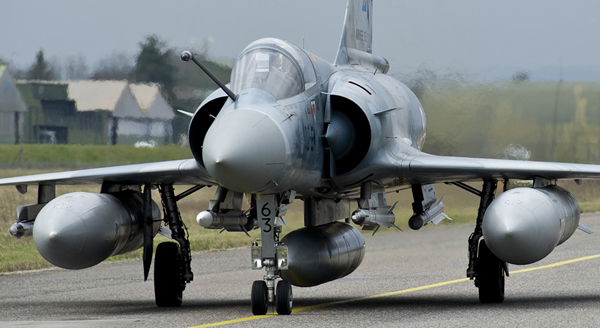
Photo: French Dassault Mirage 2000-5 aircraft prepares for take off from Dijon military base on a mission to overfly Libyan airspace in this ECPAD (French Defence communication and audiovisual production agency) handout photo, March 19, 2011.
In response, drawing on tried and true themes in Gaddafi’s rhetorical arsenal aimed at gaining sympathy from the international “Arab street”, the wannabe “king of Africa” spoke on Libyan TV to say this international military action was “simply a colonial crusader aggression that may ignite another large-scale crusader war”. Other Libyan officials have claimed the attacks have “caused some real harm against civilians and buildings”, but without any details.
In Brazil on his first – now rather overshadowed – presidential visit to Latin America, US President Barack Obama promised no US ground troops would be committed to this newest military effort – an obvious reference to the criticisms of US military actions in other Muslim states. In this, Obama and his advisors are certainly mindful of the less-than-salubrious results of George W Bush’s efforts in Afghanistan and Iraq that generated ground-force commitments that have now continued well into Barack Obama’s term as president. Obama is clearly mindful of the Colin Powell doctrine of military force in unstable states that produce a long, problematic and very costly tale of a military and political commitment to the rebuilding a nation, succinctly put as: “If you break it, it’s yours”. Or, as Obama phrased the agonies of such choices in the comments he made in Brazil: “I am deeply aware of the risks of any military action, no matter what limits we place on it. I want the American people to know that the use of force is not our first choice, and it’s not a choice that I make lightly. But we can’t stand idly by when a tyrant tells his people that there will be no mercy.”
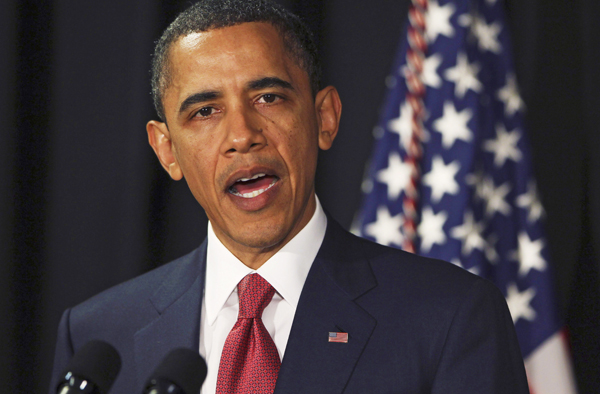
Photo: U.S. President Barack Obama announces limited U.S. military operations against Libya, in Brasilia, March 19, 2011. Obama said on Saturday that limited U.S. military action had begun to protect Libyan civilians against attacks from forces loyal Muammar Gaddafi. REUTERS/Jason Reed.
After the coordination meeting in Paris, US secretary of state Hillary Clinton told reporters, “Our assessment is that the aggressive actions by Gaddafi forces continue in many places around the country. We saw it over the last 24 hours, and we’ve seen no real effort on the part of the Gaddafi forces to abide by a cease-fire, despite the rhetoric.”
Attending the Paris meeting were prime ministers or foreign ministers from Britain, Canada, Germany, Norway, Italy, Qatar, Morocco, the United Arab Emirates, Denmark, Belgium, Spain, Poland, together with Clinton. In addition, Amr Moussa, the recently resigned secretary general of the Arab League (now planning to run for president of Egypt) was there along with the league’s new leader, Hoshyar Zebari, the foreign minister of Iraq. Also attending were the European Union foreign policy chief, Catherine Ashton, and Ban Ki Moon of the United Nations. But AU head Jean Ping travelled instead to Mauritania for a meeting with African leaders who aimed to mediate a peaceful end to the Libyan struggle.
In consistence with Obama and Clinton’s comments, US military briefers have been stressing the US would step back within days and hand over command of the coalition to one of its European allies. At present, the US already has at least 11 warships stationed near Tripoli, including three submarines, the Scranton, Florida and Providence, and destroyers the USS Stout and Barry. These forces are in addition to strategic and tactical aircraft based in Europe. Other coalition ships in the Mediterranean included various Italian, British, Canadian and French warships.
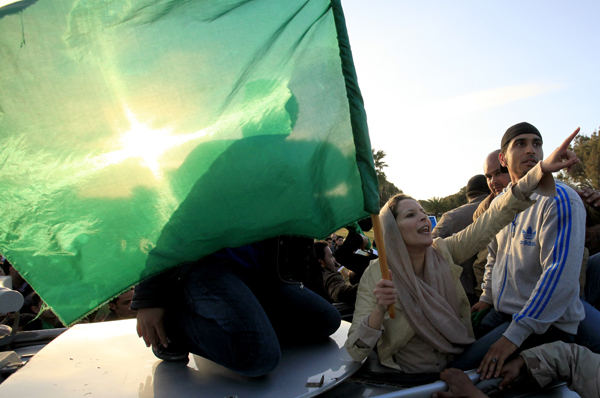
Photo: Aisha Gaddafi, daughter of Libya’s leader Muammar Gaddafi, greets supporters at Bab Al-Aziziyah in Tripoli March 19, 2011. REUTERS/Zohra Bensemra.
Meanwhile, from within Benghazi itself, still largely in the hands of the rebel forces, there are reports that Libyan government forces have carried out artillery barrages against the city and army tanks have already entered the city from the western side, with 94 casualties reported overnight. There was apparently some fighting in the city centre and pro-Gaddafi snipers have been noted near the buildings used as the rebel forces’ headquarters. In possible response to this, international TV news reports have begun reporting that there are columns of burned out military vehicles on the road into Benghazi, apparent victims of air strikes by coalition forces. Libyan media are also claiming significant numbers of civilian casualties from the air strikes including women, children and religious leaders. Air strikes, even with smart weapons don’t quite work like the ones in action films, despite the claims of the military, so civilian casualties are almost certainly on the cards, even if the current claims are bogus. Benghazi residents said government soldiers had actually reached the city centre along Gamal Abdul Nasser Road and a Soviet-era MIG-23 fighter jet that rebels had apparently captured in the early days of the uprising and that had sent against government forces went down in flames in the city. Although its pilot ejected, he was reported to have died from his injuries – or been beaten to death by locals who mistook him for a pro-Gaddafi pilot.
While the UN decision set these attacks in motion, there is as yet no obvious chapter two for this intervention, let alone an answer to whether these strikes would actually drive Gaddafi and his family from the position of power they have had for more than 40 years. Nevertheless, among the leaders at the Paris meeting, some attendees were calling for Gaddafi to surrender his position of leadership and it is possible the military intervention may provoke the Libyan government (but by whom?) to enter negotiations with the opposition about how the colonel and his family will leave the country. And, at a minimum, is it possible the military strikes will buy enough time for the rebels to regroup and stave off total military defeat or collapse?
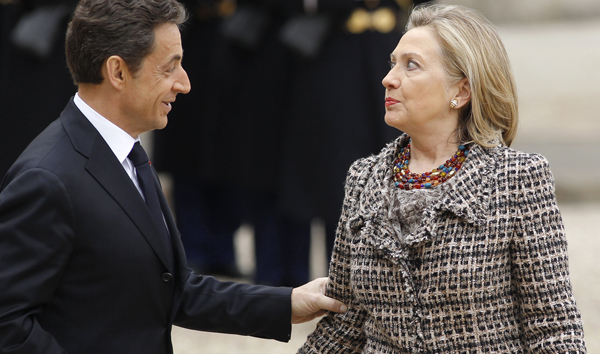
Photo: France’s President Nicolas Sarkozy (L) greets U.S. Secretary of State Hillary Clinton at the Elysee Palace ahead of wider international talks on Libya in Paris March 19, 2011. World leaders gather in Paris on Saturday to discuss a coordinated military intervention in Libya, where Muammar Gaddafi was defying the West with a final push into the rebel stronghold of Benghazi. REUTERS/Benoit Tessier.
By the same token, there are some serious downsides to the intervention. One may be a roughly and unstably divided Libya with no clear overall political authority. That, in turn, could make it easier for those inevitable Islamic extremists to begin operating in a country that has, so far, essentially been off-limits to them, despite the religiously tinged rhetoric heard from the Brother Leader’s notoriously long and rambling speeches. Gaddafi had also written letters to western leaders such as Obama, Cameron and Sarkozy, telling them: “Libya is not yours. Libya is for all Libyans. This is injustice, it is clear aggression, and it is uncalculated risk for its consequences on the Mediterranean and Europe. You will regret it if you take a step toward intervening in our internal affairs.”
In his letter to Obama, he addressed Obama as “my son”, adding that: “I have said to you before that even if Libya and the United States enter into war, God forbid, you will always remain my son, and I have all the love for you as a son, and I do not want your image to change with me. We are confronting Al Qaeda in the Islamic Maghreb, nothing more. What would you do if you found them controlling American cities with the power of weapons? Tell me how would you behave, so that I could follow your example?”
The coalition’s military intervention, now bearing one of those military-style monikers, in this case, Operation Odyssey Dawn, may also generate a contemplation of an obvious and troublesome double standard: While the West is engaging in a military punitive action against Libya, the governments in Bahrain and Yemen have faced few penalties after their own violent crackdown of their own domestic protest movements. Would the US and the rest have sought a UN resolution against Hosni Mubarak’s Egypt if military authorities had ordered the use of deadly force? Or, would it do so in the future if the Saudis ultimately carry out further actions in Bahrain or at home? No easy answer to this question, but one that may have to be addressed if the regimes on the Arabian Peninsula confront more sustained civilian opposition. As important as the Libyan struggle is, the Arabian Peninsula and the Persian Gulf will ultimately be the big prize. Real chaos there will be a deal breaker for the world. Stay tuned, there’s lots more to come in this story. DM
For more, read
- Allies Open Air Assault on Gaddafi’s Forces in Libya in The New York Times;
- Western warplanes, missiles hit Libyan targets in Reuters;
- International coalition launches strikes on Gaddafi’s forces in Libya from sea and air in the Washington Post;
- Five Allies launch Libya force as Gadhafi hits rebels in AP;
- First wave of allied assault: 112 cruise missiles in the AP;
- Libya attacked from air and sea in the BBC;
- US, Allies Attack Libya in VOA;
- Key quotes from world leaders on Libya in Reuters;
- Libya no-fly zone – live updates;
- In Benghazi: Air Strikes and Casualties in the New Yorker;
- Libya: Benghazi on the Brink in the New Yorker;
Reuters Fact box: Military assets in play in Libya crisis
FRANCE
France has some 20 fighter jets deployed in an initial operation in Libya, including Rafale multirole warplanes, Mirage fighter jets and at least one AWACS surveillance aircraft. The target area involved is an area 62×93 miles around the rebel-controlled city of Benghazi.
The French operation is being run out of the Solenzara air base in the Mediterranean island of Corsica, around an hour’s flight from Libya in a fighter jet.
France’s Charles de Gaulle aircraft carrier is on the French Mediterranean coast and will head to Libya around midday on Sunday. It could reach the Libyan coast by late Monday carrying 15 fighter jets. Its battle group includes three frigates, a fuel-supply ship and an attack submarine.
France also has air force bases near the Mediterranean towns of Marseille and Istres, about 90 minutes from Libya. Airborne refuelling tanker aircraft were ready on Friday to deploy from Istres.
France rejoined Nato’s military command in 2009, reversing four decades of self-imposed exile.
BRITAIN
Britain said it participated in a coordinated strike on Saturday against Libyan air defence systems using Tomahawk missiles launched from one of its Trafalgar-class submarines. The ministry of defence also confirmed Stormshadow missiles were launched from a number of Tornado GR4 jets flown from a Royal Air Force base 3,000 miles away in the eastern county of Norfolk in England. It said the operation was supported by VC10 and Tristar air-to-air refuelling aircraft as well as E3D Sentry and Sentinel surveillance aircraft. Typhoon jets were also standing by to provide support.
Britain has two frigates off the Libyan coast, HMS Cumberland and HMS Westminster, which could be called on to support operations. Government sources earlier said destroyers could be deployed.
US
The US started a “limited military action” in Libya several hours after France that included launching strikes along the Libyan coast targeting Libyan air defences.
The US deployed planes, cruise missiles and electronic attacks, the Pentagon said.
A defence official said the US Navy had three submarines outfitted with Tomahawk missiles in the Mediterranean ready to participate, including attack submarines USS Newport News and the USS Providence. Two Navy ships joined them.
Tomahawk missiles can cripple aircraft or anti-aircraft defences in a no-fly operation.
In all, the US Navy has five combat ships in the Mediterranean, including at least one guided-missile destroyer, but there are no aircraft carriers close to Libya.
The USS Enterprise, recently in the Red Sea, has been moved eastwards, away from Libya, to join the USS Carl Vinson in the Arabian Sea to support Afghanistan operations.
Aviano, south of the Alps in Italy, is the region’s only US air base with aircraft assigned to it – 42 F-16s. The US has military bases and installations in Italy, Greece, Spain and Turkey.
CANADA
Canada’s HMCS Charlottetown warship has joined naval actions, including a naval blockade, taking place off Libya, Prime Minister Stephen Harper told reporters.
Canadian fighter jets have reached the region, but need another day or two of preparation before they can join the mission, a Canadian government spokesman said.
ITALY
Italy has deployed dozens of combat aircraft at its base at Trapani, in western Sicily, in readiness for possible involvement in air strikes on Libya.
Tornado fighters that can be used to destroy enemy air defences and radar as well as F-16s and Eurofighters used for air-to-air defence have been moved to Trapani from bases in Piacenza in northern Italy, Gioia del Colle in Apulia.
Italy has offered the use of a Nato base near Naples for joint command centre for the operation, and could participate later on in military activities, Prime Minister Silvio Berlusconi said.
Defence minister Ignazio La Russa said in all seven bases in Italy – at Amendola, Gioia del Colle, Sigonella, Aviano, Trapani, Decimomannu and Pantelleria – were available and some allies had asked to use them.
Five are on the southern mainland or Sicily, making them some of the closest available bases to Libya.
Main photo: Seen through night-vision lenses aboard amphibious transport dock USS Ponce (LPD 15), guided missile destroyer USS Barry (DDG 52) fires Tomahawk cruise missiles in support of Operation Odyssey Dawn in the Mediterranean Sea on March 19, 2011 and released to Reuters on Saturday. This was one of approximately 110 cruise missiles fired from U.S. and British ships and submarines that targeted about 20 radar and anti-aircraft sites along Libya’s Mediterranean coast. Joint Task Force Odyssey Dawn is the U.S. Africa Command task force established to provide operational and tactical command and control of U.S. military forces supporting the international response to the unrest in Libya and enforcement of United Nations Security Council Resolution (UNSCR) 1973. REUTERS/Nathanael Miller/U.S. Navy photo/Handout

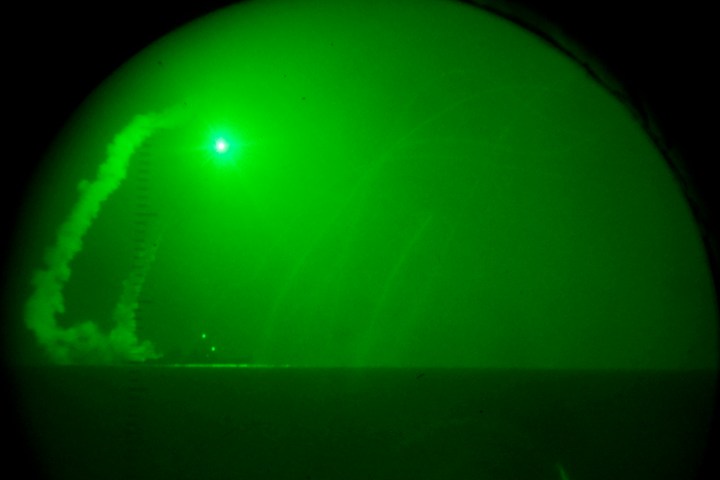

















 Become an Insider
Become an Insider